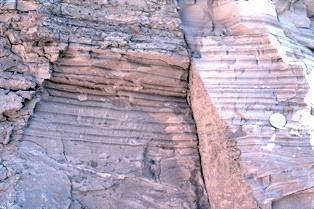Varves
Online Biology Dictionary
|
|

|
|
An outcrop containing Pleistocene-aged varves.
Scarboro Cliffs, Toronto, Ontario, Canada. Credit: Bruce F. Molnia, USGS |
Varves are regular, alternating layers in geological formations. Specifically, they are traces that reflect a yearly cycle caused by seasonal variation in factors affecting the deposition of sediments. Each varve is laid down in a year and is composed of two distinct types of sediments. One forms during cold months, and another during the warm season.
For example, during the spring and summer months, while ice is melting, strong currents in lakes and rivers favor the deposition of coarse material. But the cold months, when currents are slack, favor deposition of fine silt. The result is annual, alternating layering. Seasonal winds can also produce deposits with annual layering. Such traces are used in estimating the absolute and relative ages of geological formations.
Varves are a type of rhythmite, that is, a geological formation that reflects a temporal periodicity of any type, not only annual cycles, but also such cycles as tide, daylight, glacial expansion and withdrawal, or even very long-term events, such as planetary precession and shifts in obliquity, or changes in the eccentricity of Earth's orbit (see video at right).